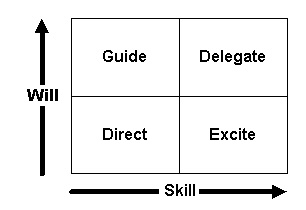Resources from the Video
- Three Things Your Marketing Must Do to Grow Your Business
- Schedule a Conversation About Your Marketing
- Digital Marketing Training Lab
The matrix can be used to assess your employee’s skill and willingness to do a specific task. Based on that assessment, you can choose how to best manage the employee towards success.

An employee is rarely in one quadrant all the time. An employee will fall into one quadrant or another depending on the task and their
- Skill: Experience with the task, training, knowledge, and natural talents.
- Will: Desire or achieve, incentives to do task, security surrounding job, confidence in abilities, and feelings about task (“attitude”)
Guide
|
Delegate
|
Direct
|
Excite
|
Source: The Skill / Will Matrix is an adaptation of Keilty, Goldsmith and Co. Inc. of
Original work by Hershey and Blanchard
cf.: Blanchard’s Four Basic Leadership Styles.
cf.: Participatory Decision Making Styles
cf.: Leadership Style and Power Grid
cf:: Blumberg Model
